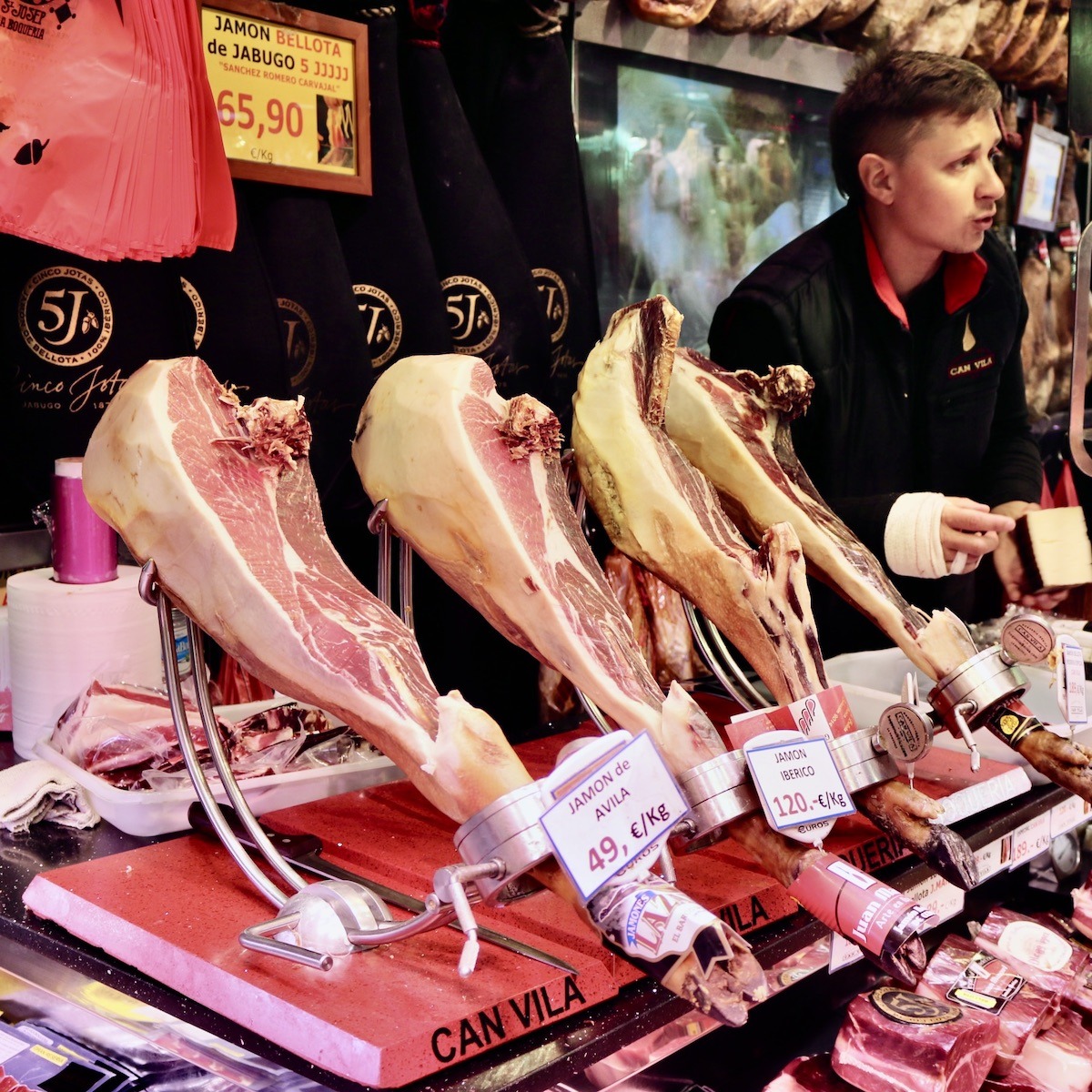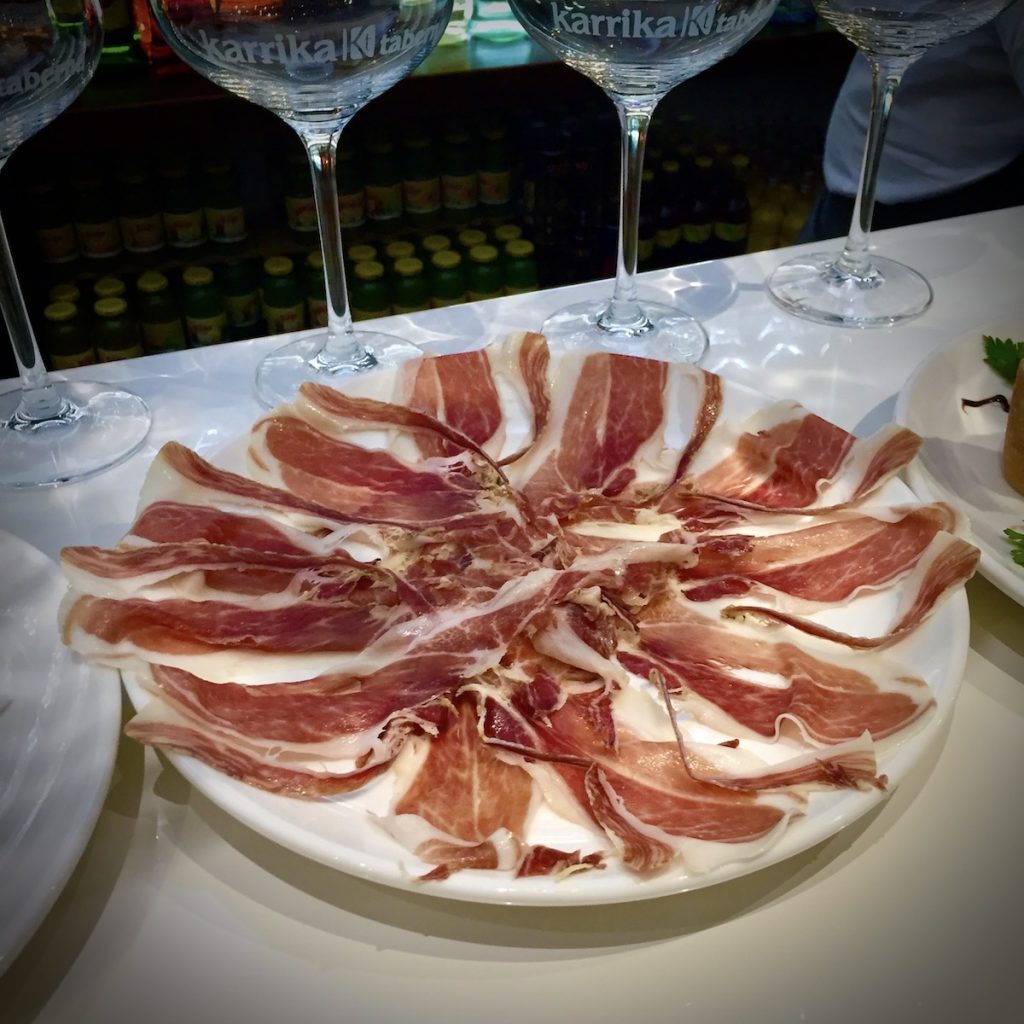What Is Jamón Ibérico?
Jamón Ibérico is a type of dry-cured ham that is traditionally produced in Spain. It is made from the hind leg of a white pig that has been salted and air-dried for several months. Jamon serrano is typically cured for 7-18 months, depending on the desired flavor and texture.
The name “serrano” refers to the mountains (Sierra in Spanish) where the ham is traditionally cured, which have a cool, dry climate ideal for curing. The hams are often hung in specially designed curing houses or bodegas, where they are left to dry and develop their distinctive flavor and aroma.
Jamon serrano is a staple of Spanish cuisine and is commonly served as a tapa, or appetizer, along with other cured meats and cheeses. It can also be used in various dishes, from soups and stews to sandwiches and salads. The flavor of jamon serrano is often described as salty and nutty, with a firm texture and a hint of sweetness.
While jamon serrano is typically made from the hind leg of a white pig, some variations use other cuts of meat or different types of pig. For example, some producers make jamon serrano from the pig’s front leg, while others use a mix of white and Iberian pig breeds. However, the traditional method of producing jamon serrano remains the most popular and widely recognized.
How Does Jamón Ibérico Compare
| Feature | Jamón Ibérico | Jamón Serrano | Prosciutto | Bacon |
|---|---|---|---|---|
| Origin | Spain | Spain | Italy | Many countries (esp. U.S., UK, Europe) |
| Animal | Iberian pig (often black-hoofed) | White pigs (Landrace, Duroc, etc.) | Primarily Italian pigs | Standard pork breeds |
| Cut | Hind leg | Hind leg | Hind leg | Belly or side of the pig |
| Curing Method | Dry-cured, air-dried | Dry-cured, air-dried | Dry-cured, air-dried | Cured (wet or dry), often smoked |
| Curing Time | 24–48 months (depending on quality) | 9–18 months | 9–24 months | 1–3 weeks usually |
| Flavor | Nutty, complex, umami-rich | Milder, slightly salty | Sweet, delicate, buttery | Salty, smoky, savory |
| Fat Content | High intramuscular fat (marbling) | Moderate fat | Moderate fat | High fat with fat strips |
| Texture | Silky, melt-in-your-mouth | Firmer than Ibérico | Tender and soft | Crisp (when cooked) or chewy (raw) |
| Serving Style | Thinly sliced, served raw | Thinly sliced, served raw | Thinly sliced, served raw | Typically cooked before eating |
| Use in Cooking | Eaten on its own, tapas, luxury dishes | Tapas, sandwiches, general dishes | Antipasto, pasta, salads | Breakfast dishes, salads, sandwiches |
| Price Range | Very expensive (especially Pata Negra) | Moderate | Moderate to expensive | Inexpensive |
| Key Difference | Comes from Iberian pigs, acorn-fed | Comes from white pigs, more common | Italian-style dry-cured ham | Cured pork belly, typically cooked |

Types
Several different types of Spanish jamón are distinguished by the breed of pig used, the pig’s diet, and the curing process. Here are some of the most common types of Spanish jamón:
| Type of Jamón Ibérico | Description | Best Uses |
|---|---|---|
| Jamón Ibérico de Bellota | Highest quality. From free-range, acorn-fed Iberian pigs. Aged 36–48 months. Rich, nutty flavor, intense marbling. | Serve thinly sliced on its own. Perfect for charcuterie boards or gourmet tapas. |
| Jamón Ibérico de Cebo de Campo | Pigs are pasture-raised and fed a mix of grains and natural forage. Aged 24–36 months. Balanced flavor and texture. | Serve with manchego, olives, or in upscale sandwiches and salads. |
| Jamón Ibérico de Cebo | Pigs raised on farms and fed cereals and legumes. Aged 24–30 months. Milder and less complex than bellota. | Great for everyday tapas, sandwiches, and pairing with wine or cheese. |
| Jamón Ibérico 100% de Bellota (Pata Negra) | Purebred Iberian pigs, exclusively acorn-fed. Often aged 48+ months. Deep flavor, melt-in-your-mouth texture. Premium designation. | Best savored alone or with a glass of fino sherry or cava. Highlight in luxury tasting menus. |
| Jamón Ibérico Reserva/Gran Reserva | Aged longer than standard cebo or cebo de campo (up to 36+ months). Label varies by producer. Enhanced depth of flavor. | Enjoy thinly sliced as a centerpiece appetizer or paired with aged cheeses. |
Jamón ibérico, also known as Iberian ham, is a type of cured ham originating from the Iberian Peninsula, which Spain and Portugal share. The ham is made from the meat of a specific breed of pig called the black Iberian pig, raised exclusively in some areas of Spain.
The Iberian pig is a unique breed well adapted to the Spanish climate and terrain, and it is allowed to roam free and graze on acorns, giving the meat its distinct flavor. The hams are cured for at least 36 months, and the process is a careful and labor-intensive one that involves salting, drying, and smoking the meat.
This process results in a ham rich in flavor and distinctive texture, with the fat content providing a soft, buttery mouthfeel. Jamón ibérico is often served in thin slices as an appetizer or as part of a charcuterie board, and a glass of wine or sherry typically accompanies it.
There are several classifications of jamón ibérico, depending on the quality and type of pig used. The highest quality ham is Jamón Ibérico de Bellota, made from pigs fed on a diet of acorns for several months before being slaughtered. This type of ham is considered a luxury food item and can be expensive.
Jamón ibérico is an integral part of Spanish cuisine and culture, and it is highly prized both within Spain and worldwide. Its unique flavor and texture make it a popular ingredient in various dishes, and its reputation as a luxury item has made it a popular gift for special occasions.
How Is It Different From Jamón Serrano?
Both types of cured ham are popular in Spain and beyond. While they may appear similar at first glance, they have several key differences.
- Breed of pig: Jamón ibérico is made from a specific breed of pig, the black Iberian pig, raised exclusively in the Iberian Peninsula. On the other hand, jamón serrano can be made from any breed of pig, although the most common is the white pig.
- Diet: Iberian pigs are known for their unique diet of acorns, which gives the meat a distinct flavor and texture. In contrast, serrano hams are typically made from pigs fed a grain diet.
- Curing time: Jamón ibérico is typically cured longer than jamón serrano, which can take as little as seven months to cure. Jamón ibérico, in contrast, is often cured for 18-36 months, with some producers going as long as 48 months.
- Cost: Due to the higher cost of raising and feeding the Iberian pigs and the longer curing time required for jamón ibérico, it is generally more expensive than jamón serrano.
- Flavor: The distinct diet of the Iberian pig gives jamón ibérico a unique flavor profile often described as nutty, buttery, and complex. Jamón serrano, on the other hand, has a milder, simpler flavor.
Is it the same as bacon?
Jamón ibérico and bacon are not the same, although they are both made from pork.
Jamón ibérico is a type of cured ham made from the meat of a specific breed of pig called the black Iberian pig, raised in some areas of Spain. The hams are cured for at least 36 months, and the process is a careful and labor-intensive one that involves salting, drying, and smoking the meat. Jamón ibérico has a rich, savory flavor and a soft, buttery texture, and it is typically served in thin slices as an appetizer or as part of a charcuterie board.
On the other hand, Bacon is a type of cured pork made from various cuts of meat, often from the belly of the pig. The meat is cured with salt and other seasonings and then smoked, cooked, or both. Bacon has a salty, smoky flavor and a crispy texture, and it is often served as a breakfast food or used as a flavorful ingredient in various dishes.
While jamón ibérico and bacon are delicious, they are made using different parts of the pig and different curing methods, resulting in distinct flavors and textures.
Is it the same as prosciutto?
Jamón ibérico and prosciutto are both types of cured ham, but they are not the same.
Prosciutto is a type of cured ham from Italy. It is made from the hind leg of a pig that has been salted and aged for anywhere from several months to several years. Prosciutto has a delicate, sweet flavor and a tender, melt-in-your-mouth texture. It is often served in thin slices as an antipasto or flavorful ingredient in various dishes.
While jamón ibérico and prosciutto are cured hams, they come from different regions and are made using different methods, giving them distinct flavors and textures.
What does jamón ibérico taste like?
Jamón ibérico has a rich and complex flavor often described as savory, nutty, and slightly sweet. The taste of jamón ibérico is influenced by several factors, including the breed of pig, the pig’s diet, and the curing process.
The meat of the black Iberian pig, the breed of pig used to make jamón ibérico, has a high-fat content that gives it a soft, buttery texture and a rich, savory flavor. The pigs are often allowed to roam free and graze on acorns, which gives the meat a slightly sweet, nutty taste.
The curing process, which can take up to 36 months or more, also plays a significant role in the flavor of jamón ibérico. During the curing process, the meat is salted, dried, and sometimes smoked, which adds depth and complexity to the flavor.
Food connoisseurs highly prize the taste of jamón ibérico, and it is often considered a delicacy. The combination of its rich, savory flavor, soft texture, and complex aroma make it a favorite among many people.
Jamon Iberico with Melon
Ingredients
- 1 ripe cantaloupe or honeydew melon
- 14 thin slices jamón ibérico
- 1 tablespoon fresh lemon juice
- 2 tablespoons olive oil extra-virgin
- black pepper freshly ground
Instructions
- Cut the cantaloupe or honeydew melon in half, remove the seeds, and cut into 1-inch thick wedges.
- Carefully wrap each melon wedge with 1 or 2 slices of jamón ibérico.
- Arrange the wrapped melon slices on a platter.
- Whisk the lemon juice and olive oil together in a small bowl, then drizzle the mixture over the melon slices.
- Finish with a sprinkle of freshly ground black pepper.
- Serve immediately and enjoy!
Notes
Jamon Iberico with Tomato Bread
Ingredients
- 4 slices rustic bread
- 2 cloves garlic
- 1 large tomato ripe
- 6 slices jamón ibérico
- olive oil extra virgin
Instructions
- Preheat the oven to 350°F (175°C).
- Slice the bread and place it on a baking sheet. Drizzle with olive oil and bake for 10-15 minutes until golden brown.
- While the bread is toasting, peel the garlic cloves and cut the tomato in half.
- Rub the garlic on the toasted bread, followed by the tomato halves, pressing down to release the juices onto the bread.
- Layer the jamón ibérico slices over the tomato bread and drizzle with a bit of olive oil.
- Serve immediately and enjoy!















One Response
This food is very delicious. Thank you for making this delicious recipe